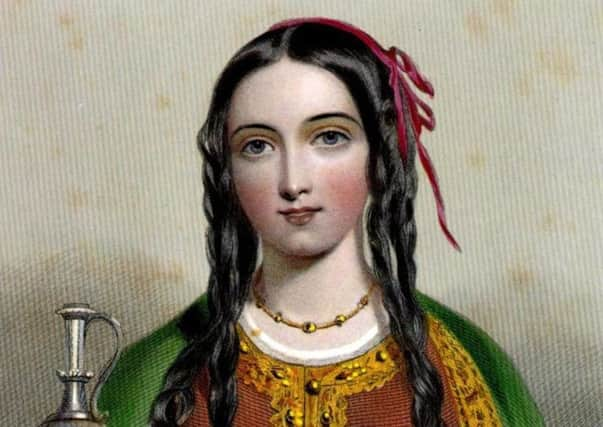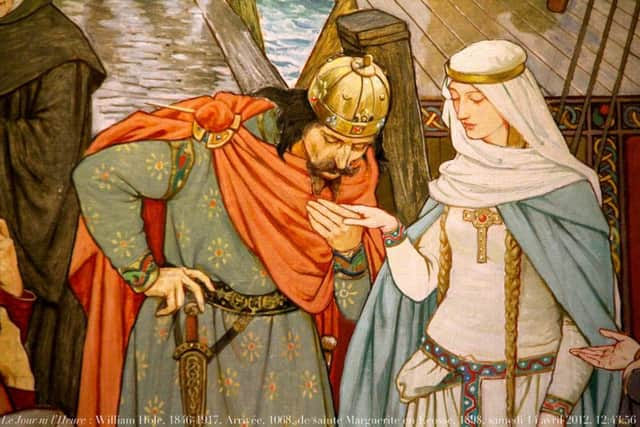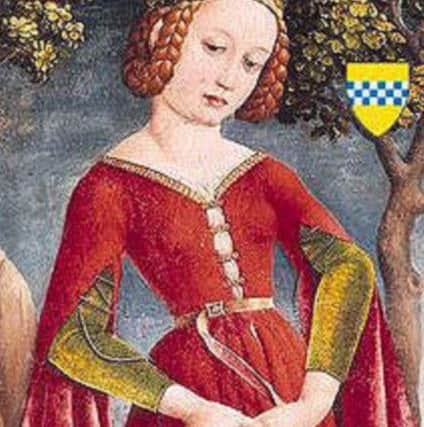5 forgotten queens and princesses of Scotland


Now a new book aims to shine a light on the women who lived at the very highest level of society - but whose history was often forgotten.
Author Erin Lawless looks at the Forgotten Royal Woman, The King and I in her new book with several leading ladies of Scotland being brought to life, at last.
1. Margaret Drummond - (c1340-1375)


Advertisement
Hide AdAdvertisement
Hide AdThe second wife and queen of David II made her mark after her husband tried to divorce her on the grounds of her infertility.
Both widowers, they were married on February 20 1364 with the union elevating Clan Drummond to a heady status.
But five years later, the marriage dream was broken with the King filing for divorce on the grounds that she was unable to bear him a child


Margaret, however, had a son with her first husband while David’s first 37-year-old marriage failed to produce any children.
Advertisement
Hide AdAdvertisement
Hide AdLawless wrote: “Margaret wasn’t about to take the divorce lying down. She escaped the control of the king’s men and travelled, incognito, to Avignon in Southern France, where the current Pope was residing.
“Said Pope agreed that there was no reason to consider she was infertile, and promptly reversed the divorce.”
David was then unable to marry his new love given Margaret’s interventions with the Pope. He died suddenly in 1371, single and alone.
2. Matilda of Scotland - (c.1080–1 May 1118)
Born Edith of Dunfermline, Matilda was the queen consort of Henry I of England and the daughter of Malcolm III, King of Scots and St Margaret.
Advertisement
Hide AdAdvertisement
Hide AdThe life of Matilda is little known and for seven years, she vanished from records altogether after walking out of the abbey where she was being raised.
She disappeared following the death of her father, brother and mother, who all died within three days of each other, but the princes re-appeared in 1100 in great style, according to Lawless.
Henry I found himself on the throne of England after the unexpected death of his brother, William II, and immediately proposed marriage to her.
English chroniclers of the time claimed that Henry had ‘long been attached’ to Edith, and even that
he ‘adored’ her.
Advertisement
Hide AdAdvertisement
Hide AdHowever, doubt surrounded whether Edith, who was educated in a convent, was actually a nun given sightings of her in a black habit.
A council of bishops concluded Edith was free to marry Henry, and following the wedding she was rechristened Matilda, a far more fitting name for a Norman queen. However, the couple were mocked for their complete lack of interest in the Norman ways of fashion and partying.
Instead, Matilda kept with her pious practices and founded leper hospitals, wore hair shirts and washed the feet of the poor.
She died in her thirties and is remembered in the nursery rhyme London Bridge is Falling Down as the ‘fair lady’ given her love of architecture and her record of building bridges.
3. Margaret of Wessex (c.1045–16 November 1093)
Advertisement
Hide AdAdvertisement
Hide AdKnown posthumously as Saint Margaret of Scotland, this English princess was born in exile and became queen-consort of Scotland.
Known for her piety and praised for her charitable works in life, she was canonised as a saint of the
Roman Catholic Church in 1250.
Margaret was the grand-daughter of Edmund Ironside, the Anglo-Saxon King and her early childhood in Hungary was a simple and religious one.
Her family returned to England following the death of Margaret’s uncle, the heirless Edward the Confessor.
Advertisement
Hide AdAdvertisement
Hide AdHer father died not long after making the journey and her little brother, Edgar, was eventually declared the King of England. He was, however, promptly kidnapped by William the Conqueror and taken to Normandy.
Lawless said: “Margaret’s mother gathered up her two little daughters and fled. Margaret’s mother succeeded in getting passage on a ship back to the continent, but a storm drove them north where they were forced to disembark in Scotland and seek the protection of the King of Scots,
The spot where the royal ladies are said to have blown ashore is still known today as Saint Margaret’s Hope.
For widower King Malcolm III, this was an amazing turn of events. He was keen to marry one of the few remaining members of the illustrious AngloSaxon royal family and so took young Margaret as his wife.
Advertisement
Hide AdAdvertisement
Hide AdThey had six sons and two daughters. She is said to have calmed her husband’s “pagan temperaments” by introducing him to religion and ‘worked tirelessly” to bring the Scottish church in line with those on the Continent to the great benefit of the common people.
She served food to orphans and washed the feet of the poor every day. A cave on the banks of the Tower Burn in Dunfermline was used by her as a place of devotion and prayer.
Both Malcolm and their eldest son were killed in the Battle of Alnwick against the English in 1093 and, stricken with grief, she died just three days later
Lawless said: “Putting aside Margaret’s undoubtedly selfless and virtuous personality, she was simply a great agent for social change in eleventh century Scotland. For generations she was held up as the very pinnacle of queenship.”
4. Isabella MacDuff (c.1285–c.1313)
Advertisement
Hide AdAdvertisement
Hide AdThis heroine of the Wars of Scottish Independence was hung in a cage for four years as punishment for supporting Robert the Bruce.
The daughter of the Earl of Fife, her family were loyal to the Bruce claim to the Scottish throne with some claiming she and a young Robert were lovers.
But Isabella was married off to the Earl of Buchan, who had links to John Balliol, the short-lived King of Scots and a hereditary enemy to the Bruce family.
Following the murder of John Comyn, Bruce’s main rival to the throne, Robert hastily travelled to Scone Palace to have himself crowned King of Scots.
Advertisement
Hide AdAdvertisement
Hide AdIsabella’s brother, the Earl of Fife, had hereditary rights to crown Scottish kings but he was a ward of court in England at the time of Bruce’s claim and could not - or would not - travel north for the coronation.
Isabella took her husband’s horse and headed for Scone where she arrived a day late for the ceremony. A second coronation was held so she could lay the crown on top of the head of the new King of Scotland and underpin the ceremony with tradition.
As a result, Isabella became estranged from her husband and was assimilated in to the Bruce household.
Following Robert I’s defeat at the Battle of Methven, Isabella was sent to the castle at Berwick-Upon-Tweed with a number of Bruce’s female relatives
Advertisement
Hide AdAdvertisement
Hide AdShe was intercepted by a supporter of Edward I and hung in a cage from the tower for at least four years in a warning to townsfolk and passing travellers. She was released and is believed to have spent the rest of her life in a friary.
5. Marjorie Bruce or de Brus - (around 1296 to 1316)
Marjorie was the eldest daughter of Robert the Bruce, King of Scots and became a princess following the coronation of her father on March 27, 1306.
However, the Royal life with fraught with danger as Edward I came down hard on the family of the new King.
The plan was for Bruce’s female relatives to head to Norway but the English found the women at Kildrummy Castle in Aberdeenshire.
Advertisement
Hide AdAdvertisement
Hide AdA brother of Bruce, Neil, defended the stronghold for as long as possible as the women fled but Marjorie and her party were captured by the Earl of Ross, an enemy of the new king.
He violated the laws of sanctuary by having the women arrested from the chapel in which they sheltered, immediately handing them over to the English, Lawless said.
Edward I refused to execute the women but he believed they should be used to illustrate the full “price of rebellion”.
Marjorie’s stepmother Elizabeth was a god-daughter of Edward I and treated gently.
Advertisement
Hide AdAdvertisement
Hide AdIsabella MacDuff (see above) and one of Marjorie’s aunts, Mary, were imprisoned in cages.
Marjorie, who was just nine-years-old, was destined for an iron cage at the Tower of London but Edward I decided to send her to a convent at Watton, Yorkshire, where she was kept in solitary confinement for the next eight years.
Following her release, her marriage to Walter, 6th High Steward of Scotland, who had distinguished himself on the field at Bannockburn, was hastily arranged.
The need for a Bruce heir was met when Marjorie became pregnant around a year after marriage.
Advertisement
Hide AdAdvertisement
Hide AdTragically, she died in a riding accident close to Paisley Abbey but her son - who was later crowned Robert II - was saved.
A cairn marks the spot called ‘the Knock’ near to where Marjorie Bruce reputedly fell from her horse.
The descendants of Marjorie’s son with Walter Steward became the House of Stewart, or Stuart.
-Forgotten Royal Woman, The King and I, by Erin Lawless is published by Pen and Sword Books and is available now
